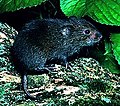Glires (/ˈɡlaɪəriːz, -aɪərz/[citation needed], Latin glīrēs 'dormice') is a clade (sometimes ranked as a grandorder) consisting of rodents and lagomorphs...
7 KB (582 words) - 14:58, 26 October 2024
sister of Glires, Primatomorpha or Dermoptera or to all other Euarchontoglires. Some old studies place Scandentia as sister of the Glires, invalidating...
14 KB (1,239 words) - 22:11, 1 December 2024
for basal Glires. Journal of Mammalian Evolution 8(1):1–71. Meng, J., Hu, Y. and Li, C. 2003. The osteology of Rhombomylus (Mammalia, Glires): implications...
5 KB (601 words) - 21:33, 17 July 2024
treeshrews as sister to both Glires and Primatomorpha cannot be ruled out. Some studies place Scandentia as sister of the Glires, which would invalidate Euarchonta:...
20 KB (1,970 words) - 16:45, 26 December 2024
called Sundatheria as the sister group of the primates. Euarchonta and Glires together form the Euarchontoglires, one of the four eutherian clades. The...
13 KB (1,095 words) - 22:22, 30 December 2024
List of placental mammals (section Grandorder Glires)
The class Mammalia (mammals) is divided into two subclasses based on reproductive techniques: monotremes, which lay eggs, and therians, mammals which give...
6 KB (263 words) - 12:29, 22 December 2024
of the primates. Some recent studies place Scandentia as sister of the Glires, invalidating Euarchonta. "Primatomorpha". Paleobiology Database. Zhang...
10 KB (791 words) - 08:19, 28 July 2024
within Euarchonta. Some studies, however, place Scandentia as sister of Glires (lagomorphs and rodents), in an unnamed sister clade of the Primatomorpha...
18 KB (1,729 words) - 03:47, 17 December 2024
manatees) Magnorder Boreoeutheria Superorder Euarchontoglires Grandorder Glires Order Lagomorpha (rabbits, hares, and pikas) Order Rodentia (rodents: mice...
24 KB (2,426 words) - 02:04, 31 December 2024
pinhead-sized thymus organ in the neck next to the trachea. Mice are mammals of the Glires clade, which means they are amongst the closest relatives of humans other...
66 KB (7,660 words) - 16:28, 19 December 2024
Concordant patterns of early origin of hypsodonty in Great Plains ungulates and Glires". Palaeogeography, Palaeoclimatology, Palaeoecology. 365–366: 1–10. Bibcode:2012PPP...
107 KB (11,617 words) - 11:34, 28 December 2024
common ancestor between lagomorphs and rodents and place them in the clade Glires. Rabbit physiology is suited to escaping predators and surviving in various...
123 KB (12,857 words) - 13:32, 18 December 2024
sister groups, sharing a single common ancestor and forming the clade of Glires. Most rodents are small animals with robust bodies, short limbs, and long...
139 KB (14,366 words) - 05:17, 30 December 2024
grasslands provided a new niche for mammals, including many ungulates and glires, that switched from browsing diets to grazing diets. Traditionally, the...
80 KB (9,235 words) - 16:25, 19 December 2024
murina – Linnaeus's mouse opossum Didelphis dorsigera − synonym of murina Glires have two cutting fore-teeth in each jaw, but no tusks, feet with claws formed...
18 KB (1,657 words) - 19:47, 28 August 2024
Catania KC, Kaas JH (2011). "Updated neuronal scaling rules for the brains of Glires (rodents/lagomorphs)". Brain, Behavior and Evolution. 78 (4): 302–14. doi:10...
112 KB (3,512 words) - 19:16, 23 December 2024
Irdin Manha Formation (section Glires)
Łcja; Li, Qian (2014-12-31). "A new genus of stem lagomorph (Mammalia: Glires) from the Middle Eocene of the Erlian Basin, Nei Mongol, China". Acta Zoologica...
30 KB (1,215 words) - 15:53, 1 November 2024
"derived" physical traits. Lagomorphs and rodents form the clade or grandorder Glires. Despite the evolutionary relationship between lagomorphs and rodents, the...
25 KB (2,640 words) - 12:36, 7 December 2024
or woodboring animals such as earthworms, ants or termites. A glirarium (glires = dormice; plural of glis) is an enclosure for housing trapped edible dormice...
15 KB (2,140 words) - 16:56, 27 August 2024
many morphological characteristics and are grouped together in the clade Glires. Anteaters of the family Myrmecophagidae are unusual in that they lack a...
55 KB (6,137 words) - 12:54, 4 December 2024
Hunter-Schreger band (section Glires)
light HSB can be seen as dark and light strips of variable width. Among Glires, the group containing rodents, lagomorphs, and their primitive relatives...
5 KB (616 words) - 19:29, 8 January 2024
in the group of the Belluae ("beasts"). He combined the rhinos with the Glires, a group now consisting of the lagomorphs and rodents. Mathurin Jacques...
70 KB (7,407 words) - 02:33, 9 December 2024
Concordant patterns of early origin of hypsodonty in Great Plains ungulates and Glires". Palaeogeography, Palaeoclimatology, Palaeoecology. 365–366: 1–10. Bibcode:2012PPP...
59 KB (5,867 words) - 12:50, 1 December 2024
Hiwegi Formation (section Glires)
The Hiwegi Formation is a geological formation on Rusinga Island in Kenya preserving fossils dating to the Early Miocene period. The Hiwegi Formation is...
52 KB (4,454 words) - 02:08, 3 January 2024
vole mitochondrial genomes increase support for both rodent monophyly and glires. Gene 294:119-129. Robovsky J, Ricánková V, Zrzavy J. 2008. Phylogeny of...
20 KB (2,170 words) - 02:04, 2 November 2024
(including the suborders Chiroptera, Insectivora and Carnivora), Tertiates (or Glires) and Quaternates (including Gravigrada, Pachydermata and Ruminantia), but...
161 KB (16,535 words) - 12:36, 26 December 2024
pikas and their extinct relatives Kingdom: Animalia Phylum: Chordata Class: Mammalia Magnorder: Boreoeutheria Superorder: Euarchontoglires Clade: Glires...
26 KB (2,919 words) - 02:09, 19 December 2024
pikas and their extinct relatives Kingdom: Animalia Phylum: Chordata Class: Mammalia Magnorder: Boreoeutheria Superorder: Euarchontoglires Clade: Glires...
47 KB (4,302 words) - 22:22, 30 December 2024
























